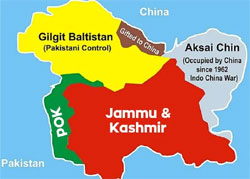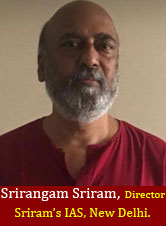The region of Gilgit-Baltistan has been in renewed focus after the reorganization of state of Jammu and Kashmir. Elaborate on the dispute surrounding the region and its present status. (250 words)
Sakshi Education
By Srirangam Sriram, Sriram's IAS, New Delhi.

Present status
Despite being controlled administratively from Islamabad since 1947, Gilgit-Baltistan continues to remain a disputed region between India and Pakistan, and hence has not been officially integrated in Pakistan.

Pakistan had changed the legal status of Gilgit-Baltistan first in 2009 by introducing Gilgit Baltistan Empowerment and Self-Governance Order-2009 which changed its name from Northern Areas to Gilgit-Baltistan. Under this arrangement, it was given a province-like status with the appointment of a chief minister and governor for self-rule. Thus, constitutionally it still remained out of Pakistan.However, Pakistan government is attempting towards incorporating the disputed region as its fifth province.
India had contested Pakistan’s several attempts to make material changes to the disputed area as the region is an integrated part of India.

At the time of partition of India in 1947, the princely state of Jammu and Kashmir consisted of five regions: Jammu, Kashmir Valley, Ladakh, Gilgit Wazarat and Gilgit Agency. Gilgit Wazarat, Gilgit Agency and a part of Kashmir valley were illegally occupied by Pakistan in 1947.
After the reorganization of the state of Jammu and Kashmir into two union territories of Jammu and Kashmir and Ladakh, areas such as Gilgit, Gilgit Wazarat, Chilhas and the Tribal Territory of 1947 that have been occupied by Pakistan, are included in the Ladakh UT.
History of the Dispute
After the reorganization of the state of Jammu and Kashmir into two union territories of Jammu and Kashmir and Ladakh, areas such as Gilgit, Gilgit Wazarat, Chilhas and the Tribal Territory of 1947 that have been occupied by Pakistan, are included in the Ladakh UT.
History of the Dispute
- In 1935, the British had had taken Gilgit Agency on a lease of 60 years from the Jammu and Kashmir maharaja. A British military officer was the administrator of Gilgit Agency, and combined region was under the control of Gilgit Scouts.
- Before exiting India, the British cancelled the lease and handed back the region to the maharaja. The security arrangement was to remain in place till an alternative was found.
- When Pakistan invaded Kashmir Valley in October 1947, the British administrator of the Gilgit agency Major William Brown revolted. Major Brown was said to be close to his English boss stationed in Karachi and preferred reporting to him than the maharaja.
- The rebels killed the maharaja's governor and a small group of Sikh and Gurkha soldiers in Gilgit. They sent a message to Karachi to occupy GilgitWazarat and Gilgit Agency proclaiming on their own accession to Pakistan for which no document was signed. They were, anyway, not in any legal position to declare accession to whichever side.
- By this time, the maharaja of Jammu and Kashmir signed the Instrument of Accession with India. Pakistan, thus, occupied GilgitWazarat and Gilgit Agency - the region is more famously known as Gilgit-Baltistan - by the treachery of British officers of the Gilgit Scouts.
Present status
Despite being controlled administratively from Islamabad since 1947, Gilgit-Baltistan continues to remain a disputed region between India and Pakistan, and hence has not been officially integrated in Pakistan.

Pakistan had changed the legal status of Gilgit-Baltistan first in 2009 by introducing Gilgit Baltistan Empowerment and Self-Governance Order-2009 which changed its name from Northern Areas to Gilgit-Baltistan. Under this arrangement, it was given a province-like status with the appointment of a chief minister and governor for self-rule. Thus, constitutionally it still remained out of Pakistan.However, Pakistan government is attempting towards incorporating the disputed region as its fifth province.
India had contested Pakistan’s several attempts to make material changes to the disputed area as the region is an integrated part of India.
Published date : 31 Oct 2020 03:22PM






